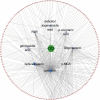The mechanism of the anti-inflammatory effect of Oldenlandia diffusa on arthritis model rats: a quantitative proteomic and network pharmacologic study
- PMID: 36388817
- PMCID: PMC9652507
- DOI: 10.21037/atm-22-3678
The mechanism of the anti-inflammatory effect of Oldenlandia diffusa on arthritis model rats: a quantitative proteomic and network pharmacologic study
Abstract
Background: In China, Oldenlandia diffusa (OD) has been prescribed as a therapeutic herb for rheumatoid arthritis (RA). We previously conducted a preliminary study of the anti-inflammatory effect of OD, and the purpose of this study is to further investigate its mechanism.
Methods: We performed a quantitative proteomic analysis of synovium, identified the differentially expressed proteins, and performed bioinformatics analyses. With the help of network pharmacology, we aimed to find the key synovial proteins which OD or its key compound might influence. To verify the result, liquid chromatography-mass spectrometry (LC-MS) was applied to quantify and qualify the absorbable potential compounds of OD. The anti-inflammatory effect was evaluated by morphological, histopathological, and cytokine analyses. Target proteins were observed by immunohistochemistry (IHC) and enzyme-linked immunosorbent assay (ELISA).
Results: MMP3 and CAV1 were identified as 2 of the differentially expressed proteins in RA synovium, and might be influenced by quercetin, the active compound of OD. MMP3 might be altered through atherosclerosis signaling, while CAV1 might be altered through caveolar-mediated endocytosis signaling. According to our verification, quercetin was identified as the absorbed and effective compound of OD, and it could exert an anti-inflammatory effect on the collagen-induced arthritis (CIA) model, including serum cytokine expression, synovial hyperplasia and lymphocyte infiltration, articular cartilage lesion. Quercetin could also down-regulate the synovial expression of MMP3 and CAV1, and could exert better effects at a high dose.
Conclusions: Quercetin was the main active compound of OD in the treatment of RA. OD might alleviate inflammatory responses in CIA rats by suppressing the expression of MMP3 and CAV1 through quercetin, and at a high dose, quercetin could exert a better anti-inflammatory effect.
Keywords: Isobaric tags for relative and absolute quantification (iTRAQ); Oldenlandia diffusa (OD); network pharmacology; rheumatoid arthritis.
2022 Annals of Translational Medicine. All rights reserved.
Conflict of interest statement
Conflicts of Interest: All authors have completed the ICMJE uniform disclosure form (available at https://atm.amegroups.com/article/view/10.21037/atm-22-3678/coif). The authors have no conflicts of interest to declare.
Figures













References
LinkOut - more resources
Full Text Sources
Miscellaneous
